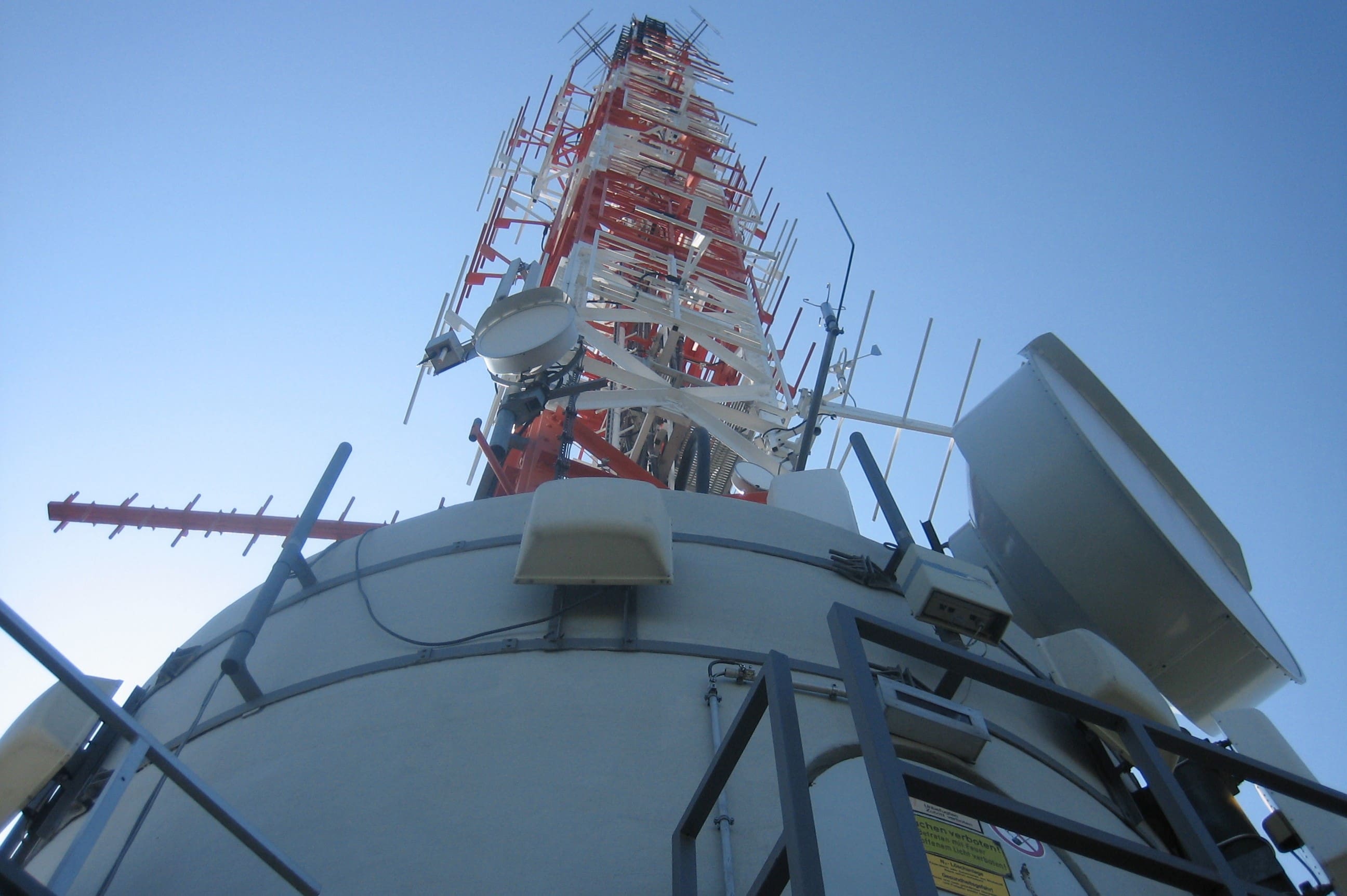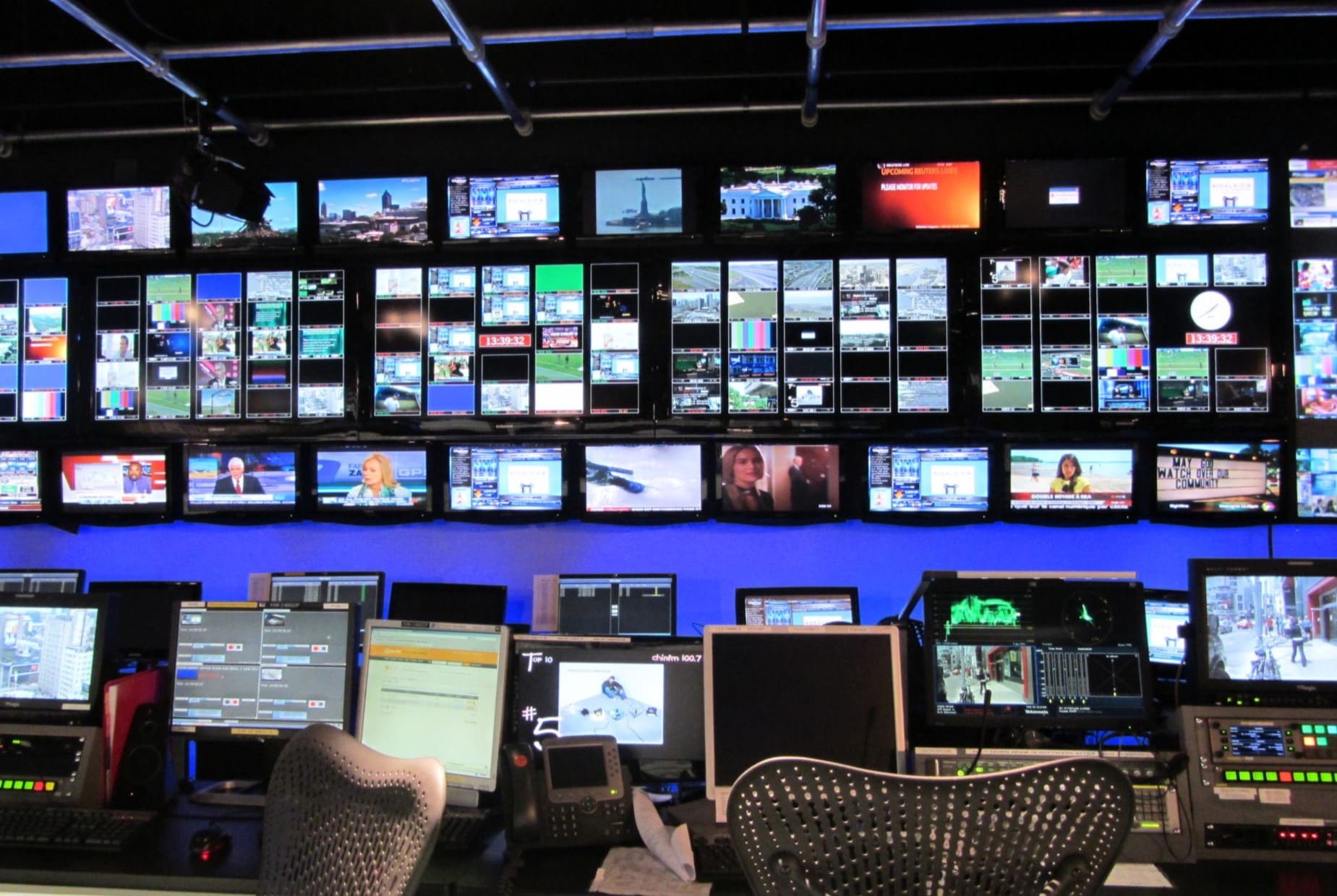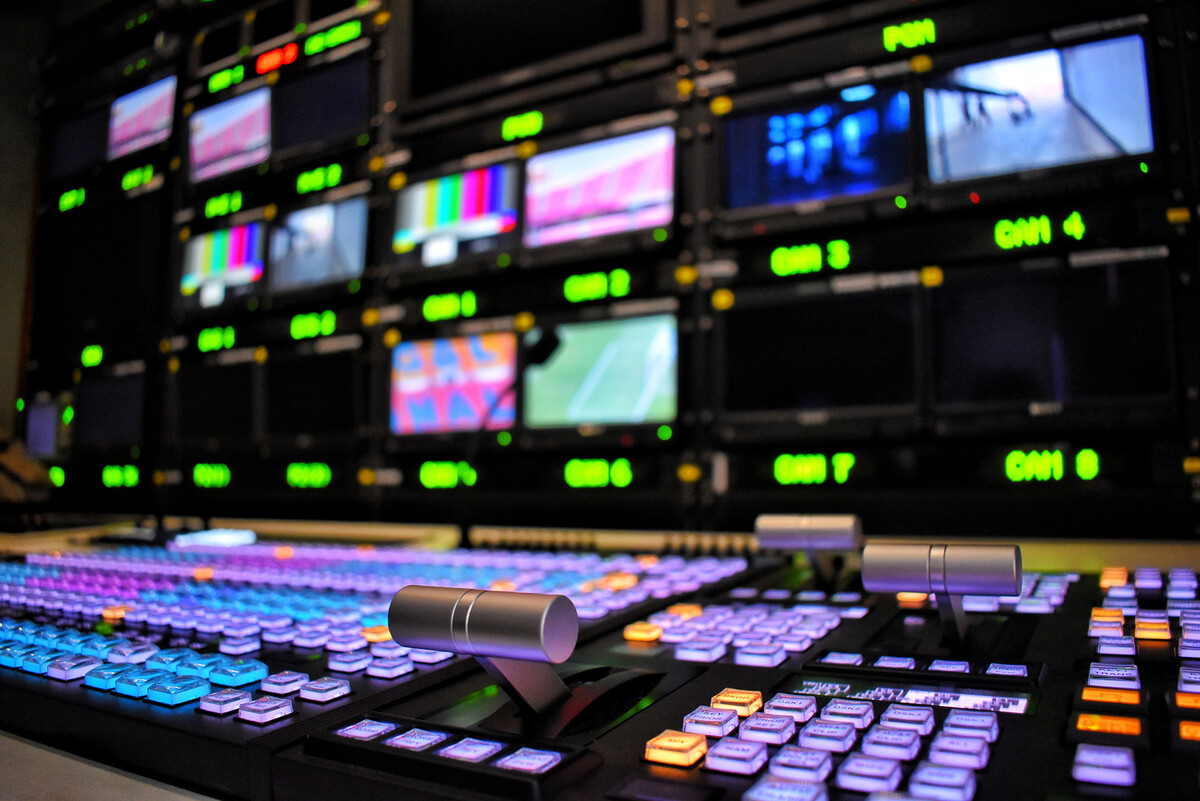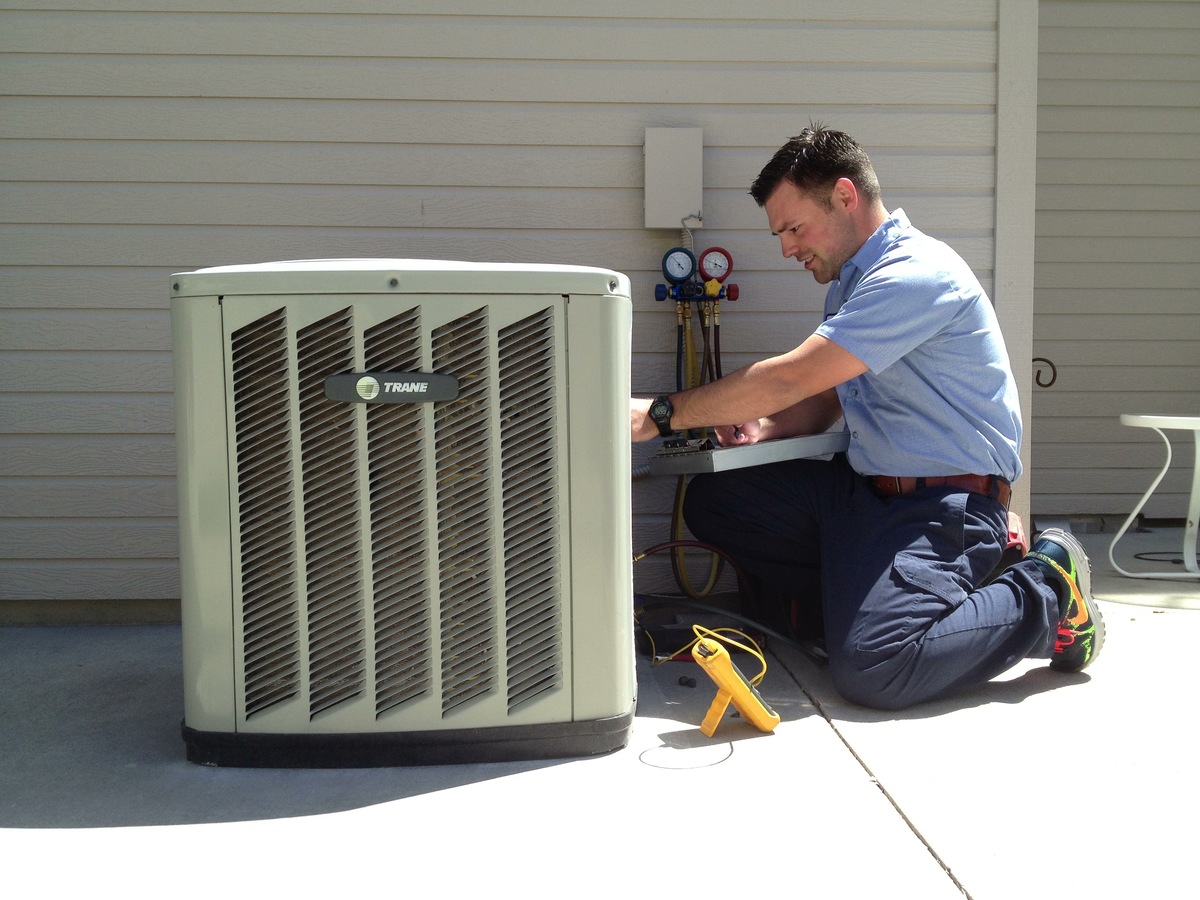Home>Technology>Home Entertainment Systems>How Do Television Stations Broadcast Live Video Across The Entire World Simultaneously?


Home Entertainment Systems
How Do Television Stations Broadcast Live Video Across The Entire World Simultaneously?
Modified: January 5, 2024
Discover the secret behind how television stations broadcast live video across the globe simultaneously with advanced home entertainment systems. Expand your viewing experience today!
(Many of the links in this article redirect to a specific reviewed product. Your purchase of these products through affiliate links helps to generate commission for Storables.com, at no extra cost. Learn more)
Introduction
Television has become an integral part of our daily lives, connecting us to a wide range of information, entertainment, and news from across the globe. Have you ever wondered how television stations are able to broadcast live video to millions of viewers simultaneously? The answer lies in the sophisticated technology and infrastructure behind the scenes.
In this article, we will explore the various methods and technologies used by television stations to transmit live video signals across the entire world. From satellite broadcasting to fiber optic networks and internet-based streaming, each method plays a crucial role in ensuring seamless and high-quality transmission.
So let’s dive into the fascinating world of broadcast signals and television technology!
Key Takeaways:
- Television broadcasting utilizes satellite, fiber optic, internet-based, and over-the-air methods to deliver live video signals globally, ensuring seamless transmission and high-quality viewing experiences for millions of viewers.
- The intricate processes of encoding, compression, transmission, and multiplexing, along with the critical roles of satellite uplink/downlink stations and Broadcast Operations Centers, are essential in the efficient and reliable delivery of live video signals in television broadcasting.
Read more: How Is Television Broadcast
Broadcast Signals and Television Technology
Before we delve into the specific methods of broadcasting live video, let’s first understand the basic principles behind broadcast signals and television technology. Television signals are essentially electrical signals that carry video and audio information from the source (such as a television studio) to the receiver (your television set).
Traditional television signals are analog, meaning they vary continuously in amplitude and frequency. However, with the advent of digital technology, most television signals are now transmitted in a digital format, consisting of a series of ones and zeros.
These digital signals offer several advantages over analog signals, including better picture and sound quality, increased resistance to noise and interference, and the ability to transmit more information in less bandwidth.
Television stations use a range of equipment and technologies to transmit and receive these signals, ensuring that viewers receive a clear and uninterrupted broadcast. Let’s explore some of the key methods used in the world of television broadcasting.
Satellite Broadcasting:
Satellite broadcasting involves the use of satellites stationed in geostationary orbit around the Earth. Television stations uplink their signals to these satellites, which then downlink the signals to receiving dishes on the ground. This enables the transmission of live video signals over vast distances, making it possible to reach viewers in different parts of the world simultaneously.
Fiber Optic Networks:
Fiber optic networks are another critical component of television broadcasting. These networks use strands of glass or plastic fibers to transmit digital signals using light. Fiber optic cables can carry a vast amount of data over long distances at high speeds, making them ideal for transmitting high-definition video signals. Many television stations rely on fiber optic networks to connect their studios, transmission sites, and broadcast towers.
Internet-based Streaming:
In recent years, the rise of the internet has revolutionized television broadcasting. Many television stations now offer live streaming services, allowing viewers to watch their favorite shows and events online. Internet-based streaming uses a combination of encoding techniques and streaming protocols to deliver live video over the internet.
Over-the-Air Broadcasting:
Over-the-air broadcasting, also known as terrestrial broadcasting, involves transmitting television signals using radio waves. Television stations broadcast their signals from tall towers located strategically to ensure widespread coverage. Viewers can receive these signals using antennas connected to their television sets.
These are just a few examples of the technologies and methods used in television broadcasting. The choice of method depends on various factors, including the geographical area to be covered, the target audience, and the available infrastructure.
In the next sections, we will explore further the equipment and infrastructure involved in television broadcasting, as well as the intricate processes of transmission, multiplexing, encoding, and compression that ensure the seamless delivery of live video signals.
Satellite Broadcasting
Satellite broadcasting is a vital method used by television stations to transmit live video signals across long distances. It involves the use of satellites positioned in geostationary orbit around the Earth, approximately 22,000 miles above the equator. These satellites act as relays, receiving signals from television stations and retransmitting them to receiving dishes on the ground.
Television stations use satellite uplink equipment to transmit their signals to the satellites. This equipment typically consists of large parabolic antennas, known as satellite dishes, that are capable of sending high-frequency signals to the satellites. The signals are then amplified and modulated with the video and audio information before being transmitted.
On the receiving end, television viewers and cable providers use satellite dishes or smaller satellite receivers to receive the signals. These receiving dishes are usually directed towards a specific satellite, allowing viewers to access the desired channels and programs.
The use of satellites for broadcasting offers several advantages. Firstly, it enables television stations to reach a wide geographic area simultaneously, making it possible to deliver live video signals to viewers in different regions of the world. This makes satellite broadcasting particularly useful for global events like sports tournaments and international news coverage.
Furthermore, satellite broadcasting provides a high level of signal quality, ensuring that viewers receive clear and uninterrupted transmissions. The signals transmitted via satellites are less susceptible to interference and signal degradation compared to other methods.
However, satellite broadcasting also has its limitations. One major challenge is the potential for signal delays or latency due to the distance the signals need to travel between the Earth and the satellite. This can result in a slight delay between the live event and its transmission to viewers.
Additionally, satellite broadcasting requires significant infrastructure and investment. Television stations need to set up satellite uplink and downlink stations, which include the necessary equipment, such as antennas, amplifiers, and satellite receivers. They also need to establish agreements with satellite operators to ensure access to the desired satellite transponders.
Despite these challenges, satellite broadcasting remains a crucial method in the television industry, enabling the seamless transmission of live video signals across vast distances. It is an essential component of global broadcasting, bringing live events, news, and entertainment to viewers worldwide.
Fiber Optic Networks
Fiber optic networks play a crucial role in television broadcasting, providing a high-speed and reliable means of transmitting live video signals over long distances. These networks use fiber optic cables, which are made up of thin strands of glass or plastic that are capable of carrying digital signals using light.
Television stations rely on fiber optic networks to connect various components of their broadcasting infrastructure, including studios, transmission sites, and broadcast towers. These networks offer several advantages over traditional copper cables, such as higher bandwidth capacity, faster data transfer rates, and increased resistance to electromagnetic interference.
When it comes to transmitting live video signals, fiber optic networks excel in delivering high-definition content with exceptional clarity and reliability. The digital signals carrying the video and audio information are converted to light pulses and transmitted through the fiber optic cables at incredible speeds.
One of the main advantages of fiber optic networks is their ability to transmit signals over long distances without significant loss of quality. Unlike electrical signals transmitted over copper cables, fiber optic signals experience minimal signal degradation over thousands of miles. This makes fiber optic networks ideal for transmitting live video signals from one location to another, whether it’s between different studios or to broadcast towers located far apart.
Furthermore, fiber optic networks can support multiple channels of high-definition video simultaneously. This means that television stations can transmit multiple live events or programs over the same fiber optic infrastructure without sacrificing signal quality. This scalability makes fiber optic networks highly efficient and cost-effective for broadcasting operations.
Setting up a fiber optic network for television broadcasting involves the installation of fiber optic cables, which are typically buried underground or installed on overhead poles. These cables are then connected to various network equipment, including switches and routers, to route the signals to their intended destinations.
While fiber optic networks offer many advantages, they also have certain challenges. Fiber optic cables are delicate and can be susceptible to damage, requiring careful handling during installation and maintenance. Moreover, establishing a fiber optic network infrastructure can be costly, as it involves significant investment in cable installation and network equipment.
Nevertheless, the benefits that fiber optic networks bring to television broadcasting make them indispensable in delivering high-quality live video signals to viewers. These networks provide the backbone for seamless and reliable transmission, enabling television stations to bring the latest news, sports events, and entertainment directly into our homes.
Internet-based Streaming
In recent years, the rise of the internet has revolutionized television broadcasting, giving rise to internet-based streaming services. This method allows television stations to transmit live video signals over the internet, making it accessible to viewers anywhere in the world with an internet connection.
Internet-based streaming relies on a combination of encoding techniques and streaming protocols to deliver live video content. The video and audio signals are first digitized and encoded into a compressed format, reducing the file size while maintaining acceptable quality. This compression allows for efficient transmission over the internet without compromising on the viewing experience.
Once encoded, the live video signals are transmitted using various streaming protocols, such as HTTP Live Streaming (HLS) or Dynamic Adaptive Streaming over HTTP (DASH). These protocols divide the video into small chunks and send them to the viewer’s device in a continuous stream. The streaming protocols dynamically adjust the quality of the video based on the viewer’s internet connection speed and device capabilities, ensuring smooth playback without buffering.
Internet-based streaming offers several benefits for both television stations and viewers. For television stations, it provides a cost-effective means of reaching a global audience without the need for satellite infrastructure or dedicated fiber optic networks. It also allows for interactive features, such as real-time commenting and social media integration, enhancing the viewer experience.
For viewers, internet-based streaming offers convenience and flexibility. They can access live video content on various devices, including smartphones, tablets, and smart TVs, at their desired time and location. Additionally, streaming services often provide on-demand features, allowing viewers to watch previously aired programs or events whenever they want.
While internet-based streaming has many advantages, it also faces some challenges. The quality and reliability of the streaming experience depend on the viewer’s internet connection speed and network congestion. Insufficient bandwidth or a weak network signal can result in buffering, pixelation, or interrupted playback. However, as internet infrastructure continues to improve globally, these challenges are becoming less prevalent.
Streaming services often require significant server and storage resources to handle the large volume of simultaneous viewers. Therefore, television stations often partner with content delivery networks (CDNs) to ensure efficient content distribution and alleviate the load on their servers.
With the increasing popularity and advancements in internet-based streaming technology, television broadcasting is evolving to adapt to the changing habits and preferences of viewers. Internet-based streaming has become a mainstay in the entertainment industry, offering a new way to access and enjoy live video content from around the world.
Over-the-Air Broadcasting
Over-the-air broadcasting, also known as terrestrial broadcasting, is a traditional method of transmitting television signals using radio waves. It involves the transmission of live video signals from a television station’s broadcast tower to antennas installed in viewers’ homes or businesses.
Television stations rely on a network of tall broadcast towers strategically located to ensure widespread coverage. These towers transmit the signals in all directions, allowing viewers within a certain range to receive the broadcasts using antennas connected to their television sets.
Over-the-air broadcasting offers several advantages. It allows viewers to access live video content without the need for a cable or satellite subscription, making it a cost-effective option for many households. Additionally, over-the-air signals are not subject to the same compression and limitations imposed by cable or satellite providers, resulting in potentially higher-quality video and audio.
To receive over-the-air broadcasts, viewers need to have an antenna installed and properly tuned to the frequency assigned to the television station. Antennas can be either indoor or outdoor, with outdoor antennas generally offering better reception due to their higher elevation.
In recent years, over-the-air broadcasting has experienced advancements in technology, thanks to the transition from analog to digital broadcasting. Digital over-the-air signals provide superior picture and sound quality compared to their analog counterparts. They also allow for the transmission of additional data, such as program guides and interactive features.
With the transition to digital broadcasting, television stations now use digital modulation techniques to encode the video and audio signals into a stream of ones and zeros. This digital stream is then transmitted over the airwaves, allowing for a more efficient use of the limited frequency spectrum.
While over-the-air broadcasting has its benefits, it also has some limitations. The range of over-the-air signals may vary depending on factors such as the terrain, surrounding buildings, and the power of the broadcast tower. In rural or remote areas, receiving reliable over-the-air signals can be challenging due to long distances from the broadcast tower.
Furthermore, over-the-air broadcasting is typically limited to local or regional coverage. Although some television stations have a strong enough signal to reach a larger area, national or international coverage requires extensive networks of broadcast towers or the use of other methods, such as satellite or cable distribution.
Despite these limitations, over-the-air broadcasting remains a popular choice for many viewers, especially those in urban areas or within proximity to broadcast towers. It offers a free and easily accessible way to receive live video content, providing a diversity of television channels and programming options.
As technology continues to evolve, over-the-air broadcasting continues to adapt, integrating new features and technologies to enhance the viewing experience. It remains a fundamental part of the television broadcasting landscape, ensuring that viewers have the choice to access live video content over the airwaves.
Television stations use satellite technology to broadcast live video across the world simultaneously. The video signal is transmitted to a satellite, which then retransmits it to receiving dishes around the world.
Broadcast Equipment and Infrastructure
Behind every television broadcast, there is a complex network of equipment and infrastructure that ensures the seamless transmission of live video signals. This equipment and infrastructure play a crucial role in capturing, processing, and distributing the content to viewers around the world. Let’s dive into the key components of broadcast equipment and infrastructure.
Cameras and Microphones:
The process begins with the capture of video and audio content using cameras and microphones. Television stations use professional-grade cameras and high-quality microphones to capture high-definition video and clear audio. These cameras are often equipped with advanced features such as zoom capabilities, image stabilization, and adjustable exposure settings.
Production Control Room:
The captured video and audio signals are then fed into a production control room, where directors and production teams manage the broadcast. The control room is equipped with advanced production switchers, audio mixers, graphics systems, and other equipment to control and enhance the live feed.
Transmission Equipment:
The transmission equipment is responsible for encoding, compressing, and modulating the video and audio signals for transmission. This equipment includes encoders, which convert the analog signals into digital format, and compression systems, which reduce the file size while preserving the quality. Modulators are used to convert the digital signals into a format suitable for transmission over specific channels or frequencies.
Transmitter and Antennas:
At the heart of the broadcast infrastructure are transmitters and antennas. Transmitters generate the radio frequency signals that carry the encoded video and audio, while antennas broadcast these signals over the airwaves. Television stations have high-power transmitters and antennas located at their broadcast towers to ensure wide coverage in their designated areas.
Studio and Control Room:
Television stations also have dedicated studio spaces where anchors, hosts, and guests present the live broadcasts. These studios are equipped with multiple cameras, green screens, lighting equipment, and other production tools. The control room in the studio manages the camera feeds, graphics, and audio levels for a seamless on-air presentation.
Infrastructure:
Behind the scenes, television stations require a robust infrastructure to support the broadcast operations. This includes networking infrastructure to connect various components, such as cameras, control rooms, and transmission equipment. Storage systems are used to archive and manage the vast amounts of video and audio content generated during broadcasts. Backup systems and redundancy measures are in place to ensure continuous operation even in the event of equipment failure.
Remote Broadcast Units:
In addition to fixed broadcast infrastructure, many television stations also utilize remote broadcast units. These units provide the necessary equipment to capture live video and audio outside of the studio, such as news reporting from the field or on-location event coverage. Remote broadcast units are equipped with mobile cameras, portable production switchers, and transmission equipment to enable live broadcasts from any location.
As technology continues to evolve, broadcast equipment and infrastructure are continually updated and upgraded to leverage the latest advancements. This ensures that television stations can deliver high-quality live video signals to viewers, offering an immersive and engaging experience.
Overall, the combination of advanced equipment, robust infrastructure, and skilled professionals working behind the scenes ensures that television stations can capture, process, and transmit live video signals with precision and efficiency.
Transmission and Multiplexing
Transmission and multiplexing are vital processes in television broadcasting, responsible for efficiently delivering multiple channels of live video signals to viewers. These processes involve the transmission of encoded video and audio signals over various mediums and the multiplexing of multiple channels to make effective use of available bandwidth.
Transmission:
Once the video and audio signals have been encoded and compressed, they need to be transmitted from the television station to the viewers’ homes or devices. The transmission process depends on the method used, such as satellite broadcasting, fiber optic networks, or over-the-air broadcasting.
In satellite broadcasting, the encoded signals are uplinked to satellites orbiting the Earth and then downlinked to receiving dishes on the ground. Fiber optic networks transmit the signals through strands of glass or plastic fibers using light pulses. Over-the-air broadcasting uses radio waves to transmit the signals from broadcast towers to the viewers’ antennas.
Transmission requires careful consideration of factors such as signal strength, bandwidth capacity, and propagation characteristics of the medium. Television stations often employ specialized equipment, such as transmitters, amplifiers, and modulators, to ensure the signals reach their intended audience with optimal quality.
Multiplexing:
Multiplexing is the process of combining multiple channels of video and audio signals into a single stream for transmission. This technique allows for efficient use of available bandwidth and optimizes the capacity of the transmission medium.
In digital television broadcasting, multiplexing is achieved through the use of MPEG (Moving Picture Experts Group) standards. These standards define how video, audio, and other data are organized and transmitted in a multiplexed format.
The most commonly used multiplexing standard is MPEG-2, which can support multiple video and audio streams within a single transport stream. Each channel is assigned a specific PID (Packet Identifier) within the multiplexed stream, allowing receivers to separate and decode the individual channels.
There are two main types of multiplexing used in digital television broadcasting:
- Time Division Multiplexing (TDM): This method involves dividing the available bandwidth into fixed time slots and allocating each channel a specific time slot. The channels take turns transmitting their data within their allocated time slots, creating the illusion of simultaneous transmission.
- Statistical Multiplexing: In this method, the available bandwidth is dynamically shared among multiple channels based on their data rate requirements. Channels with high data rates are allocated more bandwidth, while channels with lower data rates are allocated less. This allows for more efficient utilization of the available bandwidth without compromising the quality of the transmitted signals.
Multiplexing is essential for television broadcasting because it allows for the transmission of multiple channels simultaneously, enabling viewers to access a wide range of content across different channels. It maximizes the efficiency of the transmission medium and ensures the effective delivery of live video signals to viewers’ homes or devices.
Overall, the processes of transmission and multiplexing work hand in hand to ensure the efficient and reliable delivery of multiple channels of live video signals in television broadcasting. These processes enable viewers to access a diverse range of content and enjoy a seamless viewing experience.
Encoding and Compression
Encoding and compression are essential processes in television broadcasting that enable the efficient transmission and storage of live video signals. These processes involve converting analog video and audio signals into a digital format and reducing their file size without significantly compromising the quality.
Encoding:
Encoding is the process of converting analog video and audio signals into a digital format that can be easily processed, transmitted, and stored. It involves sampling the analog signals at regular intervals and converting the sampled values into digital data.
The most commonly used encoding standard in television broadcasting is MPEG (Moving Picture Experts Group). MPEG encoding algorithms use various techniques to eliminate redundancies and capture only the essential information needed to reconstruct the video and audio signals accurately.
For video encoding, MPEG standards analyze the temporal and spatial redundancies present in the video frames. Temporal redundancy refers to the similarity between consecutive frames, while spatial redundancy refers to the similarity within a given frame. By exploiting these redundancies, MPEG encoding achieves efficient compression without significant loss of quality.
Audio encoding also uses MPEG standards, such as MPEG-1 Audio Layer III, commonly known as MP3. These standards employ psychoacoustic principles to remove perceptually irrelevant audio information, reducing the file size while maintaining acceptable audio quality.
Compression:
Compression is the process of reducing the file size of digital video and audio data without significant degradation of quality. Compression is necessary to optimize bandwidth usage for transmission and storage purposes.
There are two types of compression: lossless compression and lossy compression.
Lossless compression algorithms compress the data in a way that allows it to be perfectly reconstructed, bit for bit, without any loss of information. However, lossless compression typically achieves lower compression ratios compared to lossy compression.
In television broadcasting, lossy compression is more commonly used. Lossy compression algorithms remove non-essential information from the video and audio data, resulting in some loss of quality. The degree of compression and the resulting loss in quality can be adjusted based on the desired trade-off between file size and video/audio fidelity.
MPEG compression algorithms employ a combination of intra-frame (I-frame), predictive (P-frame), and bidirectional (B-frame) coding techniques. I-frames are complete frames that are encoded independently, while P-frames and B-frames use motion compensation to encode the differences between frames, achieving higher compression ratios.
The choice of encoding and compression settings depends on various factors, including the desired video quality, available bandwidth, and storage requirements. Television broadcasters often utilize a combination of encoding and compression techniques to achieve an optimal balance between quality and efficiency.
Overall, encoding and compression are indispensable processes in television broadcasting. They enable the efficient transmission and storage of live video signals, allowing broadcasters to deliver high-quality content to viewers while optimizing bandwidth usage and storage capacity.
Read more: How Television Changed The World
Satellite Uplink and Downlink Stations
Satellite uplink and downlink stations are critical components of satellite broadcasting in television broadcasting. These stations facilitate the transmission of live video signals between television stations and satellites orbiting the Earth, enabling widespread coverage and global broadcasting.
Uplink Stations:
Satellite uplink stations are responsible for transmitting the video and audio signals from the television station to the satellites. These stations typically consist of large parabolic antennas, known as satellite dishes, which are capable of sending high-frequency signals to communicate with the satellites.
The uplink process involves converting the digital video and audio signals into radio frequency signals suitable for satellite transmission. These signals are then amplified and transmitted through the satellite dish toward the desired satellite in geostationary orbit.
Uplink stations employ advanced technologies such as high-power amplifiers and specialized modulation schemes to ensure an efficient and reliable transmission. They are equipped with backup systems and redundancy measures to maintain continuous transmission even in the event of equipment failure.
Downlink Stations:
Satellite downlink stations, on the other hand, receive the transmitted signals from the satellites and relay them to the television station or distribution network. They serve as the link between the satellite in orbit and the end viewers or cable providers.
Downlink stations consist of large receiving antennas that are designed to capture the signals beamed down from the satellites. These antennas are carefully aligned to the specific satellite’s position, ensuring optimal signal reception.
Once the signals are received, they are amplified and demodulated to recover the digital video and audio data. This data is then processed and distributed to the television station or further transmitted via other distribution methods, such as fiber optic networks or over-the-air broadcasting.
Downlink stations are equipped with advanced receiving systems, including low-noise amplifiers and high-quality demodulation equipment, to ensure the accurate retrieval of the transmitted signals. The stations also have redundancy measures in place to maintain seamless operation and minimize downtime.
The Importance of Satellite Uplink and Downlink Stations:
Satellite uplink and downlink stations are vital in satellite broadcasting as they enable television stations to reach a wide audience and deliver live video signals to viewers worldwide. They form a crucial link in the transmission chain, ensuring the seamless and reliable delivery of content from the television station to the satellites and back to end viewers.
These stations require skilled professionals who are proficient in operating and maintaining the equipment, monitoring signal quality, and troubleshooting any issues that may arise. Continuous monitoring and periodic adjustments are necessary to optimize signal strength and minimize interference or disruptions.
Overall, satellite uplink and downlink stations are integral to the success of satellite broadcasting in television. They provide broadcasters with the capability to transmit live video signals globally, facilitating the widespread dissemination of news, sports, and entertainment to viewers across the world.
Broadcast Operations Centers
Broadcast Operations Centers (BOCs) are central hubs where television stations monitor, control, and manage the various aspects of their broadcasting operations. These centers serve as the nerve center of the broadcasting process, overseeing all the technical and operational aspects that ensure a seamless and high-quality broadcast.
BOCs are equipped with advanced monitoring and control systems that allow television stations to monitor and manage every stage of the broadcasting workflow. These centers house multiple monitors, consoles, and sophisticated software applications that provide real-time information and control over the entire broadcast chain.
Monitoring:
At the core of BOCs is the monitoring system that oversees the transmission and reception of live video signals. This system continuously monitors the quality, reliability, and performance of the transmitted signals, ensuring that viewers receive clear and uninterrupted broadcasts.
These systems provide real-time feedback on parameters such as signal strength, signal-to-noise ratio, video and audio quality, modulation, and stability. If any issues or anomalies are detected, the BOC personnel can take immediate corrective actions to rectify the problems.
Control and Management:
BOCs also serve as control and management centers, allowing television stations to remotely control and manage their broadcast equipment, systems, and infrastructure. They provide centralized control over various components, such as cameras, production switchers, audio mixers, servers, and transmission equipment.
Using the control systems in the BOC, operators can switch between different video sources, adjust audio levels, monitor transmission parameters, and troubleshoot any technical issues that may arise during the broadcast. These actions can be performed in real-time, ensuring smooth and seamless operations.
BOCs are often equipped with automated scheduling and playout systems that handle the scheduling and playback of pre-recorded content, commercials, and graphics. These systems ensure the accurate timing and delivery of the scheduled programming and advertisements.
Emergency Preparedness and Recovery:
In cases of emergencies or unforeseen events that may impact the broadcast, BOCs are prepared to handle and recover from such situations. They have contingency plans and backup systems in place to ensure continuous transmission and minimal disruption, even in the event of equipment failure or power outages.
BOCs are equipped with redundant systems, backup servers, and failover mechanisms to switch to alternative equipment or transmission paths if necessary. This redundancy ensures that broadcasts can continue without interruption or with minimal downtime.
Integration and Collaboration:
BOCs serve as a hub where different teams within the television station collaborate and work together. Technicians, engineers, producers, directors, and other personnel can communicate effectively within the BOC to coordinate their efforts and ensure a smooth broadcast.
BOCs often integrate with other departments, such as newsrooms, traffic departments, and programming departments, to streamline operations and facilitate efficient content delivery. By maintaining effective communication and collaboration, BOCs enable smooth transitions between live content, commercials, and other programming elements.
Overall, Broadcast Operations Centers are instrumental in the successful management, control, and monitoring of television broadcasting operations. With their advanced systems and skilled personnel, BOCs ensure that broadcasts are delivered with the highest quality, reliability, and efficiency, keeping viewers engaged and connected to the world of live television.
Conclusion
Television broadcasting has undergone remarkable transformations over the years, enabling the seamless transmission and delivery of live video signals to millions of viewers worldwide. From satellite broadcasting to fiber optic networks, internet-based streaming, and over-the-air broadcasting, various methods and technologies have emerged to meet the demands of an ever-evolving media landscape.
Throughout this article, we have explored the intricate processes and technologies involved in television broadcasting. We have delved into the importance of broadcast signals and television technology, understanding the transition from analog to digital signals, and the advantages of digital transmission.
Satellite broadcasting has showcased its ability to reach a global audience simultaneously, providing wide coverage and high-quality transmission. Fiber optic networks have revolutionized broadcasting with their capacity for high-speed data transfer and long-distance transmission without compromising on video and audio quality.
Internet-based streaming has emerged as a popular and convenient method, allowing viewers to access live video content from anywhere at any time, while over-the-air broadcasting continues to provide an accessible and cost-effective option for many households.
We have also explored the critical role of broadcast equipment and infrastructure, such as cameras, control rooms, antennas, and transmission equipment, in capturing, processing, and distributing live video signals. These components work in tandem to deliver a seamless and immersive viewing experience to audiences.
The encoding and compression processes have shown how analog signals are converted into digital format, optimized for efficient transmission and storage. The utilization of encoding and compression techniques ensures the effective use of available bandwidth while maintaining acceptable video and audio quality.
Lastly, we have explored the significance of satellite uplink and downlink stations, as well as the essential functions of Broadcast Operations Centers. These centers oversee and manage the technical aspects of broadcasting operations, from monitoring and control to emergency preparedness and recovery, ensuring the uninterrupted delivery of live video signals.
In conclusion, television broadcasting has come a long way, becoming an indispensable part of our daily lives. The combination of advanced technologies, skilled professionals, and sophisticated infrastructure contributes to the seamless transmission and delivery of live video signals to viewers worldwide.
As technology continues to evolve, we can expect television broadcasting to adapt and embrace new innovations, providing viewers with even more captivating and immersive experiences. Whether it is through satellite broadcasting, fiber optic networks, internet-based streaming, or over-the-air transmission, television broadcasting will continue to connect us, entertain us, and keep us informed in the ever-expanding world of home entertainment systems.
Frequently Asked Questions about How Do Television Stations Broadcast Live Video Across The Entire World Simultaneously?
Was this page helpful?
At Storables.com, we guarantee accurate and reliable information. Our content, validated by Expert Board Contributors, is crafted following stringent Editorial Policies. We're committed to providing you with well-researched, expert-backed insights for all your informational needs.














0 thoughts on “How Do Television Stations Broadcast Live Video Across The Entire World Simultaneously?”